Poliovirus cis-acting replication element-dependent VPg Uridylylation lowers the Km of the initiating nucleoside triphosphate for viral RNA replication
- PMID: 18653453
- PMCID: PMC2546976
- DOI: 10.1128/JVI.00427-08
Poliovirus cis-acting replication element-dependent VPg Uridylylation lowers the Km of the initiating nucleoside triphosphate for viral RNA replication
Abstract
Initiation of RNA synthesis by RNA-dependent RNA polymerases occurs when a phosphodiester bond is formed between the first two nucleotides in the 5' terminus of product RNA. The concentration of initiating nucleoside triphosphates (NTPi) required for RNA synthesis is typically greater than the concentration of NTPs required for elongation. VPg, a small viral protein, is covalently attached to the 5' end of picornavirus negative- and positive-strand RNAs. A cis-acting replication element (CRE) within picornavirus RNAs serves as a template for the uridylylation of VPg, resulting in the synthesis of VPgpUpU(OH). Mutations within the CRE RNA structure prevent VPg uridylylation. While the tyrosine hydroxyl of VPg can prime negative-strand RNA synthesis in a CRE- and VPgpUpU(OH)-independent manner, CRE-dependent VPgpUpU(OH) synthesis is absolutely required for positive-strand RNA synthesis. As reported herein, low concentrations of UTP did not support negative-strand RNA synthesis when CRE-disrupting mutations prevented VPg uridylylation, whereas correspondingly low concentrations of CTP or GTP had no negative effects on the magnitude of CRE-independent negative-strand RNA synthesis. The experimental data indicate that CRE-dependent VPg uridylylation lowers the K(m) of UTP required for viral RNA replication and that CRE-dependent VPgpUpU(OH) synthesis was required for efficient negative-strand RNA synthesis, especially when UTP concentrations were limiting. By lowering the concentration of UTP needed for the initiation of RNA replication, CRE-dependent VPg uridylylation provides a mechanism for a more robust initiation of RNA replication.
Figures
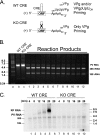
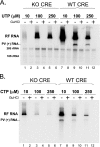
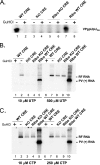
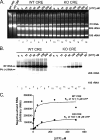
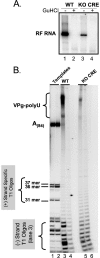

Similar articles
-
Initiation of protein-primed picornavirus RNA synthesis.Virus Res. 2015 Aug 3;206:12-26. doi: 10.1016/j.virusres.2014.12.028. Epub 2015 Jan 12. Virus Res. 2015. PMID: 25592245 Free PMC article. Review.
-
Poliovirus CRE-dependent VPg uridylylation is required for positive-strand RNA synthesis but not for negative-strand RNA synthesis.J Virol. 2003 Apr;77(8):4739-50. doi: 10.1128/jvi.77.8.4739-4750.2003. J Virol. 2003. PMID: 12663781 Free PMC article.
-
Conversion of VPg into VPgpUpUOH before and during poliovirus negative-strand RNA synthesis.J Virol. 2009 Dec;83(24):12660-70. doi: 10.1128/JVI.01676-08. Epub 2009 Oct 7. J Virol. 2009. PMID: 19812161 Free PMC article.
-
Genetic and biochemical studies of poliovirus cis-acting replication element cre in relation to VPg uridylylation.J Virol. 2000 Nov;74(22):10371-80. doi: 10.1128/jvi.74.22.10371-10380.2000. J Virol. 2000. PMID: 11044081 Free PMC article.
-
Uridylylation of the genome-linked protein of poliovirus in vitro is dependent upon an endogenous RNA template.Virus Res. 1987 Sep;8(3):193-204. doi: 10.1016/0168-1702(87)90015-3. Virus Res. 1987. PMID: 2825442 Review.
Cited by
-
Initiation of protein-primed picornavirus RNA synthesis.Virus Res. 2015 Aug 3;206:12-26. doi: 10.1016/j.virusres.2014.12.028. Epub 2015 Jan 12. Virus Res. 2015. PMID: 25592245 Free PMC article. Review.
-
Effects of TDP2/VPg Unlinkase Activity on Picornavirus Infections Downstream of Virus Translation.Viruses. 2020 Jan 31;12(2):166. doi: 10.3390/v12020166. Viruses. 2020. PMID: 32023921 Free PMC article.
-
Picornavirus RNA polyadenylation by 3D(pol), the viral RNA-dependent RNA polymerase.Virus Res. 2015 Aug 3;206:3-11. doi: 10.1016/j.virusres.2014.12.030. Epub 2015 Jan 3. Virus Res. 2015. PMID: 25559071 Free PMC article. Review.
-
An Extended Primer Grip of Picornavirus Polymerase Facilitates Sexual RNA Replication Mechanisms.J Virol. 2020 Jul 30;94(16):e00835-20. doi: 10.1128/JVI.00835-20. Print 2020 Jul 30. J Virol. 2020. PMID: 32522851 Free PMC article.
-
Unmasking the information encoded as structural motifs of viral RNA genomes: a potential antiviral target.Rev Med Virol. 2013 Nov;23(6):340-54. doi: 10.1002/rmv.1756. Epub 2013 Aug 27. Rev Med Virol. 2013. PMID: 23983005 Free PMC article. Review.
References
-
- Agol, V. I., A. V. Paul, and E. Wimmer. 1999. Paradoxes of the replication of picornaviral genomes. Virus Res. 62129-147. - PubMed
-
- Amiott, E. A., and J. A. Jaehning. 2006. Mitochondrial transcription is regulated via an ATP “sensing” mechanism that couples RNA abundance to respiration. Mol. Cell 22329-338. - PubMed
-
- Amiott, E. A., and J. A. Jaehning. 2006. Sensitivity of the yeast mitochondrial RNA polymerase to +1 and +2 initiating nucleotides. J. Biol. Chem. 28134982-34988. - PubMed
Publication types
MeSH terms
Substances
Grants and funding
LinkOut - more resources
Full Text Sources
Research Materials

